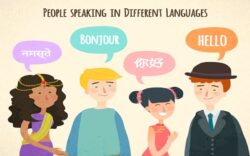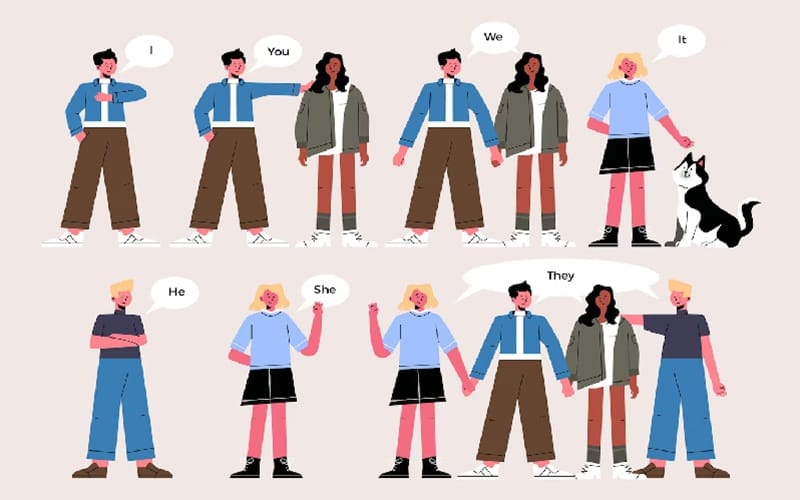Space, Time, characters, events, causation and relationships are things that we expect to encounter in the study of the physical world, but the work of theoretical linguists has shown that these concepts also figure in the grammar of human language; explicitly and formally, in syntactic and semantic representations (Carol Tenny). In linguistics, a grammatical gender is a specific form of a noun class system, where nouns are assigned to gender categories that are often not related to the real-world qualities of the entities denoted by those nouns or gender-based adjective endings. This classification is a feature of many languages, though not all languages have gendered nouns. Unlike Arabic, French and Spanish, Finnish language has no specific gendered articles (e.g., “el” or “la” “he” “she” “هو” “هي” in Arabic, English and Spanish respectively).
Sataa (Fiinnish)
Il pleut (French)
إنها تمطر (Arabic)
In Finnish language, the third person singular pronoun “hän” can refer to both “he” and “she” in English, as it doesn’t differentiate between genders, hough none of the inflections in a language relate to sex or gender. To specify gender, Finnish uses words like “mies” for a man and “nainen” for a woman. Finnish nouns are gender-neutral. This means that there are no specific gendered articles or gender-based adjective endings. According to one estimate, gender is used in approximately half of the world’s languages. According to one definition: “Genders are classes of nouns reflected in the behaviour of associated words.
Import spacy #Load the language modelnlp = spacy.load("en_core_web_sm") #Process a sentencedoc = nlp("the cat is on the table") #Access tokens and their attributesfor token in doc:print(token.text, token.pos_, token.tag_) #Example of getting genderfor token in docif token.tag_ == "PRP"print (f"Token: {token.text}, Gender{token._.gender}")Unlike many other languages, English, has no grammatical gender for nouns. English uses natural gender to denote the sex of living beings (e.g., boy/girl, man/woman) and relies on context or specific words (e.g., actor/actress, waiter/waitress) to indicate gender when necessary. Nouns in the Arabic language are gendered. There are two genders: Feminine and masculine. The masculine gender is the main gender. To make a noun feminine, the letter “ة” is added at the end as “طبيبة” ”طبيب” ”مدرس” ”مدرسة” The gender agreement case in omitting the type of confusion that occurs in establishing genders of inanimate objects, i.e. chair, pen, etc. The gender of a noun is an essential aspect of the language and affects the forms of associated words, such as articles, adjectives, and pronouns.
To work with grammatical gender in Arabic using Python, you’ll need to leverage Natural Language Processing (NLP) libraries. One popular library for NLP tasks is NLTK (Natural Language Toolkit). Here’s a basic outline of how you can approach this:
import nltk from nltk.tokenize import word_tokenize nltk.download('averaged_perceptron_tagger') def get_arabic_gender(word): tagged = nltk.pos_tag(word_tokenize(word))if tagged[0][1] == 'JJ': return 'adjective' elif tagged[0][1] == 'NN': return 'noun' else:return 'unknown' word = 'بيت' # Example Arabic word (meaning 'house')
gender = get_arabic_gender(word) print(f"The grammatical gender of '{word}' is {gender}.")Further Analysis:
You can perform additional analysis or processing based on the extracted nouns and their associated genders. Remember, this approach relies on a pre-trained part-of-speech tagger for Portuguese (which is the closest available for Arabic in NLTK). It may not be as accurate as specialized models for Arabic. Keep in mind that working with grammatical gender in Arabic can be complex due to the rich inflection system. This basic approach may not cover all cases accurately.
If you need more advanced and accurate results, you might want to consider using dedicated NLP models that are specifically trained for Arabic, like the ones provided by the Hugging Face Transformers library. Please note that the availability of libraries and models might change over time, so make sure to check for the latest resources. Here are some key points about grammatical gender in Arabic:
Masculine Nouns (المذكر):
Generally, nouns referring to male beings or objects are considered masculine. For example, “رجل” (rajul) meaning “man” is a masculine noun.
Feminine Nouns (المؤنث):
Nouns referring to female beings or objects are considered feminine. For example, “امرأة” (imra’a) meaning “woman” is a feminine noun.
Gender Agreement:
Adjectives, articles, and pronouns must agree with the gender of the noun they modify. For example, if you’re describing a feminine noun like “امرأة” (imra’a), you would use feminine forms of adjectives and pronouns.
Gender-Neutral Nouns:
Some nouns in Arabic do not have a specific gender. These are considered “common gender” nouns and do not follow the typical masculine/feminine categorization.
Plural Forms:
Both masculine and feminine nouns have different plural forms. The plural forms also affect the agreement of associated words.
Changing Gender in Diminutives:
In some cases, when forming diminutives (expressing smallness or endearment), the gender of the noun might change. For instance, “ولد” (walad) meaning “boy” can become “وليد” (waleed) in the diminutive form.
Learn Noun Genders:
Learning the gender of nouns is crucial in Arabic because it dictates many aspects of the language’s grammar and syntax. Remember that there are patterns and rules that can help determine the gender of many nouns, but there are also exceptions, so practice and exposure to the language are essential for becoming proficient.
A Narrative Space Feature
“Grammatical gender” is a linguistic feature found in many languages where nouns are categorized as masculine, feminine, or neuter. This classification is not necessarily based on biological gender, but rather it’s a grammatical aspect of the language. In some languages, like Spanish or French, every noun has a gender, and adjectives and articles must agree in gender with the noun they modify. For example, in Spanish, “el libro” (the book) is masculine, while “la mesa” (the table) is feminine.
Gender and number of Arabic words
Regarding “narrative space feature,” this term doesn’t have a widely recognized linguistic meaning. It might refer to a specialized aspect of language or a concept in a specific context that’s not immediately familiar to me. If it’s from a specific field or author, more context would be needed to provide a precise answer. If you have a specific context or source in mind, please provide more information, and I’ll do my best to assist you further. Grammatical gender, also known as gender agreement or noun class, is a linguistic feature found in many languages. It is a system of classifying nouns into distinct categories, typically labeled as masculine, feminine, and sometimes neuter. This classification is often arbitrary and does not necessarily correspond to biological sex.
The use of grammatical gender can affect the agreement of other elements in a sentence, such as articles, adjectives, and pronouns. For example, in Spanish, the noun “book” (libro) is masculine, so associated words like “the” (el) and “good” (bueno) must also be in the masculine form (“el libro bueno”).
It’s important to note that not all languages have grammatical gender. English, for instance, largely abandoned this feature, with only a few remnants like ships being referred to as “she.” In a narrative context, the use of grammatical gender can add depth and nuance to characters and objects, influencing how they are described and interact within the story. This feature can be particularly important in languages where gender is an integral part of the grammar.
Most recently, I have begun to look at the interface of grammar and modality. How exactly does this abstract human faculty of grammar interact with the physical means of expression, such as vocal or manual articulation?
Grammatical gender refers to a system of noun classification found in many languages, where nouns are categorized as masculine, feminine, or neuter (or other similar categories). This classification may not necessarily correspond to biological gender, and it exists primarily for grammatical purposes.
In terms of narrative space, grammatical gender can play a significant role in shaping the way a story is told. It can influence the characterization of individuals or objects, as well as the relationships between them. For example, in languages with grammatical gender, the choice of articles, adjectives, and sometimes even verbs may be determined by the gender of the noun.
This linguistic feature can add depth and nuance to a narrative, allowing authors to convey subtle meanings and emotions. It can also affect the reader’s perception and interpretation of the text. For instance, in some cases, the gender of a noun might be used to create tension, humor, or symbolism within the story.
Overall, understanding the implications of grammatical gender in a particular language can be crucial for both writers and readers, as it can significantly impact the texture and flow of a narrative. Keep in mind that the specific effects may vary depending on the language and its grammatical structure.Welcome to WordPress. This is your first post. Edit or delete it, then start writing!
















